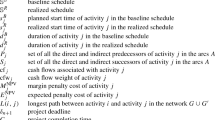Abstract
When the Net Present Value (NPV) of a project is used as a measure of its financial performance, effective management of cash flows over the duration of the project is critical for improved profitability. Progress payments are a major component of project cash flows. In many project environments, the contractor can negotiate payment terms. Payments are typically tied to completion of project activities and therefore have significant impact on the schedule of activities and the timing of the payments. In this paper, we consider the problem of simultaneously determining the amount, timing and location of progress payments in projects to maximize NPV. Due to the combinatorial nature of the problem, heuristics are a practical approach to solving the problem. We propose a two-stage heuristic where simulated annealing is used in the first stage to determine a set of payments. In the second stage, activities are rescheduled to improve project NPV. We compare the performance of this general purpose heuristic with other problem-dependent heuristics from the literature. Our results indicate that the simulated annealing heuristic significantly outperforms the parameter-based heuristics. Although rescheduling in the second stage improves NPV, increases are relatively small in magnitude. While the specific parameters settings suggested by the simulated annealing heuristic in this study may have limited generalizability at this time due to the narrow range of problems tested, our analysis suggests that a pure simulated annealing approach is a very attractive alternative for obtaining good heuristic solutions to the complex problem of scheduling payments in projects.
Similar content being viewed by others
References
E.H.L Aarts and P.J.M. van Laarhoven, Statistical cooling: A general approach to combinatorial optimization problems, Phillips Journal of Research 40(4) (1985) 193–226.
E.S. Abernathy, Managing a contractor's billings, Journal of Accountancy (1990).
A.I. Ali, R. Padman and H. Thiagarajan, Dual algorithms for pure network problems, Operations Research 37(1) (1989) 159–171.
R.B. Bey, R.H. Doersch and J.H. Patterson, The net present value criterion: Its impact on project scheduling, Project Management Quarterly (June 1981).
F.F. Boctor, Resource constrained project scheduling by simulated annealing, International Journal of Production Research 34(8) (1996) 2335–2351.
K. Bouleimen and H. Lecoq, A new efficient simulated annealing algorithm for the resourceconstrained project scheduling problem, in: Proceedings of the Sixth International Workshop on Project Management and Scheduling, eds. G. Barbaroso?lu, S. Karabati, L. Özdamar and G. Ulusoy (Bo?aziçi University Printing Office, Istanbul, 1998) pp. 19–22.
M.R. Brusco and L.W. Jacobs, A simulated annealing approach to the cyclic staff-scheduling problem, Naval Research Logistics 40 (1993) 69–84.
M.R. Brusco and L.W. Jacobs, A simulated annealing approach to the solution of flexible labour scheduling problems, Journal of the Operational Research Society 44(12) (1993) 1191–1200.
N. Dayanand and R. Padman, Payments in projects: A contractor's model, Working Paper 93-71, The Heinz School of Public Policy and Management, Carnegie Mellon University, Pittsburgh, PA 15213 (1993).
N. Dayanand and R. Padman, On modelling payments in project networks, Journal of the Operational Research Society 48(9) (1997) 906–918.
N. Dayanand and R. Padman, Project contracts and payment schedules: The client's problem, Management Science, forthcoming.
R.H. Doersch and J.H. Patterson, Scheduling a project to maximize its present value: A zero-one programming approach, Management Science 23(8) (1977) 828–839.
R.W. Eglese, Simulated annealing: A tool for operational research, European Journal of Operational Research 46 (1990) 271–281.
S.E. Elmaghraby, Activity nets: A guided tour through some recent developments, European Journal of Operational Research 82 (1995) 383–408.
S.E. Elmaghraby and W.S. Herroelen, The scheduling of activities to maximize the net present value of projects, European Journal of Operational Research 49 (1990) 35–49.
R.D. Gilbreath, Managing Construction Contracts (Wiley, 1992).
R.C. Grinold, The payment scheduling problem, Naval Research Logistics Quarterly 19(1) (1972) 123–136.
C. Hendrickson and T. Au, Project Management for Construction (Prentice-Hall, Englewood Cliffs, NJ, 1989).
A. Isaac, Analysis of risks in bidding lump sum implementation contracts, in: Proceedings of the Annual Seminar/Symposium of the Project Management Institute (1990).
D.E. Jeffcoat and R.L. Buffin, Simulated annealing for resource constrained scheduling, European Journal of Operational Research 70 (1993) 43–51.
D.S. Johnson, C.R. Aragon, L.A. McGeoch and C. Schevon, Optimization by simulated annealing: An experimental evaluation; part I, graph partitioning, Operations Research 37(6) (1989) 865–892.
S. Kirkpatrick, C.D. Gelatt Jr. and M.P. Vecchi, Optimization by simulated annealing, Science 220 (1983) 671–680.
T.E. Morton and D.W. Pentico, Heuristic Scheduling Systems: With Applications to Production Systems and Project Management (Wiley, 1993).
R. Padman and D.E. Smith-Daniels, Early-tardy cost trade-offs in resource constrained projects with cash flows: An optimization based approach, European Journal of Operational Research 64 (1993) 295–311.
B. Pollack-Johnson and M. Liberatore, Project management software usage and patterns and suggested research directions for future development, Project Management Journal 29(2) (1998) 19–28.
C. Reeves, ed., Modern Heuristic Techniques for Combinatorial Optimization (Blackwell Sci., 1991).
A.H. Russell, Cash flows in networks, Management Science 16(5) (1970) 357–373.
R.A. Russell, A comparison of heuristics for scheduling projects with cash flows and resource restrictions, Management Science 32(10) (1986) 1291–1300.
D. Smith-Daniels, R. Padman and V. Smith-Daniels, Heuristic scheduling of resource constrained projects with cash flows, Naval Research Logistics 44 (1997) 364–381.
B.F. Talbot, Resource-constrained project scheduling with time resource tradeoffs: The nonpremptive case, Management Science 28(10) (1982) 1197–1210.
A.J. Vakharia and Y.L. Chang, A simulated annealing approach to scheduling a manufacturing cell, Naval Research Logistics 37 (1990) 559–577.
M.R. Weidman, ed., Project and Program Management: A Guide to Managing Project Risks and Opportunities, The PMBOK Handbook Series 6, Project Management Institute, Drexel Hill, PA, Preliminary edition, 1992. For trial use and comment.
K.K. Yang and J.H. Patterson, Scheduling a resource-constrained project with alternative activity performance modes using simulated annealing, Working Paper (1995).
Author information
Authors and Affiliations
Rights and permissions
About this article
Cite this article
Dayanand, N., Padman, R. A Two Stage Search Heuristic for Scheduling Payments in Projects. Annals of Operations Research 102, 197–220 (2001). https://doi.org/10.1023/A:1010910316909
Issue Date:
DOI: https://doi.org/10.1023/A:1010910316909




